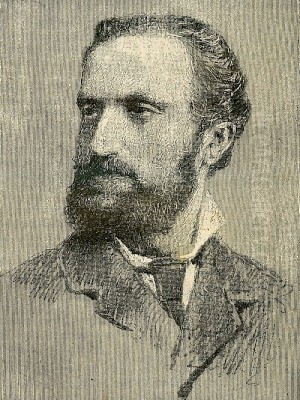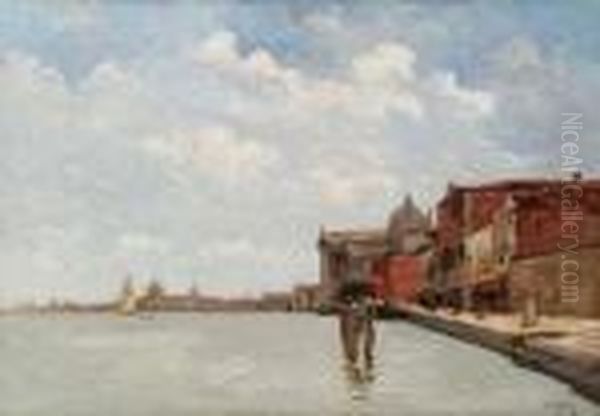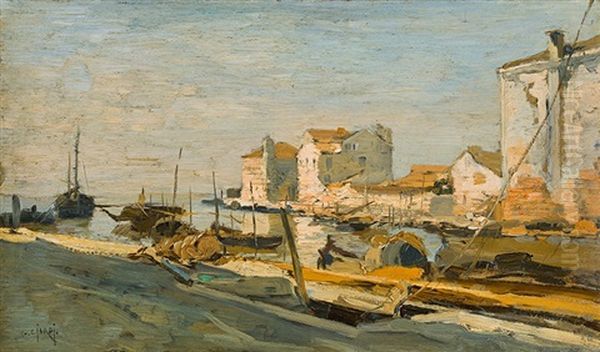
Guglielmo Ciardi stands as a pivotal figure in nineteenth-century Italian art, particularly renowned for his evocative landscape paintings. Born in the heart of Venice in 1842 and passing away in the same city in 1917, Ciardi dedicated his artistic life to capturing the unique atmosphere and luminous beauty of his native region. His work masterfully bridges the gap between traditional Venetian veduta painting and the burgeoning modern approaches to art that characterized his era.
Ciardi's canvases are celebrated for their focus on the Venetian lagoon, the surrounding Veneto countryside, and scenes from Lombardy. He possessed an exceptional sensitivity to the effects of light and color, rendering the interplay of water, sky, and land with a style that blended meticulous Realism with the vibrant, light-filled techniques associated with Impressionism. His compositions often favored simplicity and harmony, allowing the natural beauty of the landscape to speak for itself.
Early Life and Artistic Formation in Venice
Guglielmo Ciardi's artistic journey began formally at the prestigious Venice Academy of Fine Arts (Accademia di Belle Arti di Venezia). Here, he received a rigorous academic training under the tutelage of respected painters Federico Mola and, notably, Domenico Bresolin. Bresolin, himself a landscape painter, likely instilled in the young Ciardi a foundational appreciation for depicting the natural world.
The academic environment provided Ciardi with essential skills in drawing, composition, and traditional painting techniques. This solid grounding would serve him throughout his career, even as he began to explore more innovative artistic paths. His connection to the Academy remained strong; later in his career, he would return as an esteemed professor, eventually succeeding his former mentor, Domenico Bresolin, in teaching landscape painting. This role highlights his standing within the Venetian art establishment and his commitment to passing on artistic knowledge.
The Florentine Experience and the Macchiaioli Influence
A significant turning point in Ciardi's artistic development occurred in 1868 when he traveled to Florence. This journey brought him into contact with the Macchiaioli, a group of revolutionary painters based primarily in Tuscany. Facilitated by an introduction from the Venetian painter Federico Zandomeneghi, Ciardi met key figures of the movement, including the influential artist and critic Telemaco Signorini.

The Macchiaioli championed a style characterized by painting outdoors (en plein air), capturing immediate sensory impressions, and using 'macchie' (patches or spots) of color and chiaroscuro to define form and light. They sought a greater sense of realism and immediacy, breaking away from the polished conventions of academic art. Ciardi's interactions with Signorini, Giovanni Fattori, and Silvestro Lega proved profoundly influential.
During his time in Florence, Ciardi engaged in discussions about light theory and observed the Macchiaioli's methods firsthand. While he never fully adopted the 'macchia' technique in its purest form, the emphasis on capturing fleeting light effects, the commitment to naturalism, and the practice of outdoor sketching deeply impacted his approach. This period marked a decisive shift away from purely academic constraints towards a more personal and modern interpretation of landscape.
Telemaco Signorini recognized the young Venetian's talent. He reviewed Ciardi's work, specifically mentioning a painting titled Una Marina (A Seascape), praising its powerful depiction of Venice and its innovative qualities in an article for the Gazzetta d'Italia. This critical endorsement from a leading figure of the Italian avant-garde undoubtedly bolstered Ciardi's confidence and reputation. The Florentine sojourn was instrumental in shaping the mature style that would define his career.
Travels and Broadening Artistic Horizons
Ciardi's artistic curiosity extended beyond Venice and Florence. From a young age, around eighteen, he embarked on travels throughout Italy, seeking diverse landscapes and engaging with different artistic communities. His journeys took him to major art centers like Rome and Naples, further enriching his visual vocabulary and technical repertoire.
In Naples, Ciardi encountered Filippo Palizzi, a prominent painter associated with the Scuola di Resina, known for its realistic depictions of rural life and nature. Painting alongside Palizzi and interacting with the Neapolitan art scene exposed Ciardi to different approaches to realism and landscape painting, complementing the influences he absorbed in Florence. These experiences reinforced his commitment to observing nature directly and capturing the specific atmospheric conditions of each location.
These travels were not mere sightseeing expeditions; they were integral to his artistic practice. Ciardi actively sought out opportunities to study light effects in various environments, from the coastal regions to the inland countryside. This dedication to plein air observation became a hallmark of his work, allowing him to infuse his paintings with a sense of authenticity and immediacy. His travels helped him revive and reinterpret the tradition of Venetian landscape painting, moving beyond picturesque views to explore more profound connections between light, atmosphere, and place.
Artistic Style and Techniques

Guglielmo Ciardi's mature artistic style is a sophisticated synthesis of various influences, unified by his distinct personal vision. While rooted in the Venetian tradition of landscape painting, his work incorporates elements of nineteenth-century Realism and the light-centric concerns of Impressionism, without strictly adhering to any single movement.
A defining characteristic of Ciardi's art is his mastery of light and atmosphere. He excelled at capturing the subtle nuances of the Venetian climate – the hazy mornings, the bright midday sun reflecting on the water, the tranquil glow of twilight over the lagoon. His brushwork, often fluid and expressive, effectively conveys the textures of water, clouds, and land.
His color palette, while capable of vibrancy, often demonstrated a refined sensibility. Academic sources note his tendency towards using color essentially, sometimes reducing the range to achieve a greater tonal harmony and focus on light effects. He understood how light affects local color and used this knowledge to create paintings that feel both realistic and emotionally resonant. The influence of the Macchiaioli is evident in his attention to chiaroscuro and the way patches of color define form, though his application was generally more blended and less stark than that of painters like Fattori.
Ciardi also displayed an innovative approach to subject matter. While he painted recognizable Venetian landmarks, he was equally drawn to the less conventional aspects of the landscape – the quiet, marshy areas of the lagoon, the working boats, the expansive fields of the Veneto. He explored what some might term "non-places," scenes not typically chosen for grand veduta paintings, finding beauty and poetry in the everyday and the overlooked aspects of his environment. This focus lends his work a sense of intimacy and authenticity.
Key Themes and Subjects: The Venetian Soul
The heart of Guglielmo Ciardi's oeuvre lies in his profound connection to Venice and its surrounding territories. The Venetian lagoon, in all its varied moods and times of day, was a recurring and central theme. He painted the bustling canals, the quiet backwaters, the islands dotting the lagoon, and the vast expanses where water meets sky. His depictions often include the characteristic boats of the region – fishing vessels, sailboats, gondolas – integrating human activity naturally within the landscape.
Ciardi's fascination extended beyond the city itself into the Veneto countryside, particularly the areas around Treviso. These works often depict rural scenes, fields under cultivation, river landscapes, and the gentle light of the mainland. Paintings like Harvest showcase his ability to capture the textures of the earth and the atmospheric conditions of the agricultural landscape with the same sensitivity he applied to the lagoon.
His choice of subjects reflects a deep love for his native region and an intimate understanding of its character. He moved beyond the purely picturesque, seeking to convey the unique spirit and atmosphere of Venice and the Veneto. His works are not just topographical records; they are lyrical interpretations, imbued with a sense of place and often a quiet, contemplative mood. This focus on capturing the essential character of the landscape cemented his reputation as a leading figure in Venetian painting.
Representative Masterpieces
Several key works exemplify Guglielmo Ciardi's artistic achievements and stylistic characteristics. These paintings showcase his skill in rendering light, atmosphere, and the specific character of the Venetian landscape.
Pesca in Laguna (Fishing in the Lagoon / Hunting in the Lagoon): Often cited as a quintessential Ciardi work, this painting (or series of works on the theme) perfectly captures the serene and expansive atmosphere of the Venetian lagoon. It typically features fishing boats on calm waters under a vast sky. Ciardi uses soft light and a harmonious color palette to evoke a sense of tranquility and timelessness. The delicate rendering of reflections on the water and the subtle gradations of color in the sky highlight his mastery of light effects.
Fondamento di Venezia (Venice Foundation): Described by scholars as a peak of inspiration, this work delves into the complex visual tapestry of Venice at the water's edge. It likely depicts the foundations of buildings meeting the canal waters, focusing on the rich textures of stone, algae, water, and reflections. The painting is noted for its sensory richness, capturing the interplay of light and shadow on varied surfaces and perhaps even suggesting the underwater world hinted at by the murky canal waters. It showcases Ciardi's ability to find artistic depth in seemingly ordinary urban details.
Canale della Giudecca (Giudecca Canal): This subject, depicting one of Venice's major waterways, allowed Ciardi to explore dynamic compositions involving water traffic, architecture, and expansive skies. Works with this title often demonstrate his skill in handling complex light situations, contrasting brightly lit areas with deep shadows. The detailed rendering of boats and buildings provides a sense of place and historical context, while the overall atmospheric treatment remains paramount.
Messe (Harvest): Moving inland, this painting represents Ciardi's engagement with the rural landscapes of the Veneto. It captures a scene of agricultural activity, likely depicting fields during harvest time. Scholars note the detailed division of color areas and the sophisticated handling of light and shadow, demonstrating Ciardi's profound understanding of nature observed outdoors. It reflects the influence of Realism and potentially the Barbizon School's focus on rural life, interpreted through Ciardi's unique lens.
Una Marina (A Seascape): This is the work famously praised by Telemaco Signorini. While the specific image may vary, seascapes by Ciardi generally emphasize the horizon, the movement of water, and the effects of weather and light on the sea and sky. Signorini's positive review suggests this early work already displayed the strong personal vision and innovative approach to capturing the Venetian environment that would characterize Ciardi's career.
These representative works collectively illustrate Ciardi's range, his technical skill, and his consistent focus on capturing the luminous essence of the landscapes he knew and loved.
Ciardi as Educator and Mentor
Beyond his prolific output as a painter, Guglielmo Ciardi made significant contributions as an educator. His appointment as Professor of Landscape Painting ('Vedute') at the Venice Academy of Fine Arts, succeeding his own teacher Domenico Bresolin, underscores his respected position within the Italian art world. This role allowed him to directly shape the next generation of Venetian artists.
His teaching likely emphasized the principles he valued in his own work: careful observation of nature, understanding the effects of light and atmosphere, and solid technical grounding combined with personal expression. While specific details of his pedagogical methods are scarce in the provided sources, his influence can be seen in the work of artists who studied or interacted with him.
One notable example is Eugenio Bonivento (1880-1956), a later Venetian painter whose work clearly shows Ciardi's influence. Bonivento adopted Ciardi's focus on lagoon landscapes, his sensitivity to light, and his nuanced use of color, albeit often with a brighter, more distinctly Impressionistic palette in his mature work.
Interestingly, Ciardi's influence extended even to artists associated with later, more radical movements. The Futurist artist known as Baldessari reportedly learned from Ciardi's techniques, particularly regarding enhancing the luminosity of color and mastering traditional methods, which Baldessari would then adapt to his own avant-garde purposes. This suggests that Ciardi's technical mastery and understanding of light were recognized and valued even by artists pursuing very different aesthetic goals.
The Ciardi Artistic Dynasty
Artistic talent ran strongly in the Ciardi family, creating a notable dynasty within the Venetian art scene. Guglielmo Ciardi was not the only painter in his immediate family; two of his children, Emma and Beppe, also became accomplished artists, carrying forward the family's legacy while developing their own distinct styles.
Emma Ciardi (1879-1933) achieved considerable recognition in her own right. While influenced by her father's dedication to landscape and light, Emma developed a unique style often characterized by a lighter, more decorative touch and a focus on elegant garden scenes, Venetian festivals, and Rococo-inspired themes. Her work sometimes evokes the spirit of 18th-century Venetian painters like Francesco Guardi and Pietro Longhi, blending historical charm with Impressionistic brushwork. She gained international acclaim, exhibiting widely in Europe and America.
Beppe Ciardi (1875-1932), Guglielmo's son, also pursued a career as a painter. He largely followed in his father's footsteps, focusing on Venetian landscapes and lagoon scenes. His style often closely resembled his father's, particularly in his treatment of light and atmosphere, though perhaps with variations in palette or composition. The continuation of the family's artistic focus across generations highlights the deep connection the Ciardis had to the Venetian landscape and its painterly traditions. This familial artistic environment undoubtedly fostered a rich exchange of ideas and techniques within the Ciardi household.
Exhibitions, Recognition, and Critical Reception
Throughout his career, Guglielmo Ciardi actively exhibited his work, gaining recognition both within Italy and internationally. He regularly participated in the Venice Biennale exhibitions, a major platform for contemporary art. His paintings were also shown in other Italian cities and abroad, including Paris, which was then the epicenter of the art world.
His participation in major exhibitions ensured his work was seen by critics, collectors, and fellow artists, contributing to his growing reputation. The positive review by Telemaco Signorini in 1868 was an early and significant endorsement from a key figure in the Italian avant-garde. Such critical attention helped solidify his position as an important contemporary painter.
The consistent quality and appeal of his Venetian landscapes earned him commercial success and critical acclaim during his lifetime. His ability to capture the unique beauty of Venice resonated with both local audiences and the increasing number of international visitors drawn to the city. His works entered important private and public collections. Today, his paintings are held in numerous museums, with a significant presence noted in institutions like the Musée d'Orsay in Paris, confirming his lasting international importance.
Legacy and Academic Evaluation
Academic assessment places Guglielmo Ciardi as one of the most significant figures in Italian landscape painting of the latter half of the nineteenth century. He is primarily celebrated for revitalizing the Venetian landscape tradition, infusing it with modern sensibilities derived from Realism and Impressionism while retaining a strong personal and poetic vision.
Scholars emphasize his mastery of light and atmosphere as his most defining contribution. His nuanced depictions of the Venetian lagoon and the Veneto countryside are considered benchmarks of naturalist observation combined with artistic sensitivity. His influence extended beyond his immediate circle, impacting subsequent generations of Venetian painters like Eugenio Bonivento and even providing technical grounding for artists like the Futurist Baldessari.
His connection with the Macchiaioli is seen as a crucial phase in his development, pushing him towards greater naturalism and plein air practice, although he ultimately forged his own path rather than becoming a strict adherent to their style. His work represents an important bridge between the academic traditions of the mid-nineteenth century and the more modern approaches that emerged towards its end.
Ciardi's life and work have been the subject of scholarly study, documented in monographs and exhibition catalogues by art historians such as Nino Barbantini, Pietro Dini, and Luigi Menegoni. These studies affirm his importance within the context of nineteenth-century Italian art. The continuation of artistic practice by his children, Emma and Beppe Ciardi, further cemented the family's name in Venetian art history.
Conclusion: Enduring Vision of Venice
Guglielmo Ciardi's legacy endures through his luminous and evocative paintings. He captured the soul of Venice and its environs with unparalleled sensitivity to light and atmosphere. By skillfully blending academic training with the innovative spirit of his time, particularly the influences of the Macchiaioli and Impressionism, he created a body of work that is both historically significant and aesthetically captivating. His dedication to observing nature, his technical mastery, and his poetic interpretation of landscape secure his place as a master of nineteenth-century Italian art and one of the most beloved painters of Venetian light. His work continues to offer viewers a timeless vision of the beauty and unique character of his native region.